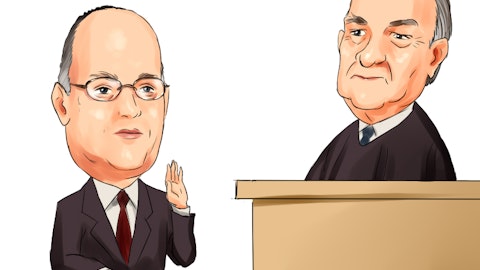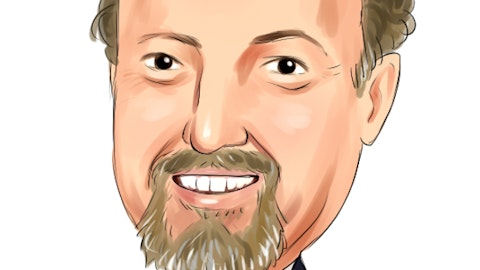PagSeguro Digital Ltd. (NYSE:PAGS) Q4 2022 Earnings Call Transcript March 2, 2023
Operator: Good evening. My name is Nihuge, and I will be your conference operator today. Welcome to PagBank PagSeguro’s webcast results for the Third Quarter 2022. At this time, all lines have been placed on mute to prevent any background noise. This event is also being broadcast live via webcast and may be accessed through PagBank PagSeguro’s website at investors.pagseguro.com. Participants may view the slides in any order they wish. Today’s conference is being recorded and will be available after the event is concluded. I would now like to turn the call over to your host, Eric Oliveira, Investor Relations and ESG Director. Please, go ahead.
Eric Oliveira: Hi everyone. Thanks for joining our fourth quarter 2022 earnings call. After the speakers’ remarks, there will be a question-and-answer session. Before proceeding, let me mention that any forward-looking statements included in the presentation or mentioned on this conference call are based on currently available information and PagBank PagSeguro’s current assumptions, expectations, and projections about future events. While PagBank PagSeguro believes that the assumptions, expectations, and projections are reasonable in view of currently available information, you are cautioned not to place undue reliance on these forward-looking statements. Actual results may differ materially from those included in PagBank PagSeguro’s presentation or discussed on this conference call, for a variety of reasons, including those described in the forward-looking statements and risk factor sections of PagBank PagSeguro’s most recent Annual Report on Form 20-F and other filings with the Securities and Exchange Commission, which are available on PagBank PagSeguro’s investor relations website.
Finally, I would like to remind you that during this conference call the company may discuss some non-GAAP measures, including those disclosed in the presentation. We present non-GAAP measures when we believe that the additional information is useful and meaningful to investors. The presentation of this non-GAAP financial information, which is not prepared under any comprehensive set of accounting rules or principles, is not intended to be considered separately from, or as a substitute for, our financial information prepared and presented in accordance with IFRS as issued by the IASB. For more details, the foregoing non-GAAP measures, and the reconciliation of these non-GAAP financial measures to the most directly comparable IFRS measures, are presented in the last page of this webcast presentation and earnings release.
With that, let me turn the call over to Ricardo. Thank you.
Ricardo Dutra: Good evening from Sao Paulo, everyone, and thanks for joining our webcast for the fourth quarter 2022 results. Tonight, I have the company of Alexandre Magnani, our CEO, Artur Schunck, our CFO, and Eric Oliveira, Head of Investor Relations and ESG. Before I turn to Alexandre, I would like to share a quick overview of our journey, as we completed 5 years as a public listed company last January. After that, I will share the main 2022 achievements and comment about our ESG initiatives. Going to Slide 3, we share the 5 years key performance indicators for our company, and the 3 years key performance indicators for PagBank, our financial services and digital bank unit launched in May 2019. Our company truly experienced an exponential growth and scale over the years, including millions into the financial system, initially through payments, and then through digital bank and financial services.
We have been successfully unlocking new addressable markets in payments and financial services, always balancing growth and profitability. Starting with PagSeguro data, our TPV grew 9x in 5 years, reaching BRL354 billion, and we have the largest payment’s network acceptance in Brazil, accounting for more than 7 million active merchants. PagBank, our financial services and digital bank business, has been growing consistently in all important metrics, increasing engagement, unlocking cross-selling opportunities, and leveraging our banking license to reduce our cost of funding. PagBank TPV increased 19x, with total deposits growing 10x, surpassing more than BRL20 billion. Our credit portfolio grew 7x, reaching BRL2.7 billion, still very small compared with the opportunity we have ahead of us.
And finally, even with all investments in our organic growth and the macroeconomic challenges such as interest rate increases, inflation, and uncertainty about consumer spending, not only in Brazil, but around the world, our profits grew 3x. And our equity position increased from less than BRL1 billion in 2017 to almost 12 billion in the end of 2022. On the chart in the right of the slide, we can see that 52% of the 2022 equity figure is composed by retained earnings, fully reinvested in our organic growth. Going to Slide 4, we can see some of our 2022 achievements. We successfully implemented our repricing to offset financial expenses increase. At the same time, we had strong deposit growth, which helped to reduce our funding costs and helped to diversify our funding sources.
We also have been successfully diversifying our payments business and 2022 marked the consolidation of our HUBs initiative to extend our best-in-class services to small and mid-sized clients, and PagBank consolidated as the second largest digital bank in Brazil, with 28 million clients. In credit underwriting, we took the right decision in Q1 2022 to shift our underwriting from unsecured products to secured products. By doing so, we were able to unlock new growth avenues such as the payroll loans and credit cards backed by CDs and account balance savings, improving our gross profit in PagBank. Finally, our disciplined capital allocation led to a significant improvement in operating and investing cash flow generation, paving our path to further explore the opportunities in Payments and Financial services in the Brazilian territory in the coming years.
Moving to Slide 5, our natural call for disruption and value creation led us to set a high bar for deliveries in ESG. In December 2022, we released our second sustainability report, where every stakeholder can follow our main initiatives and positive impact in society. One point to highlight here is that our financial inclusion has been massive, through a safe and hassle-free platform, empowering clients, employees, and communities. With that, I finish my presentation and pass the word to Alexandre Magnani.
Alexandre Magnani: Thank you, Ricardo. Hello, everyone. After Ricardo shared our main achievements for 2022, I would like to share our highlights only for the fourth quarter, beginning in the Slide 6. Our investment philosophy to balancing growth and profitability while keeping a disciplined capital allocation led us to report the highest EPS in PAGS’ history, 36% higher than the same period of 2021; strong revenue growth above 20% versus 4Q21, reaching almost BRL4 billion; cash earnings of BRL410 million, almost 4x higher than 4Q21; and BRL9.8 billion in net cash position, further boosted by our efficiencies in OpEx and CapEx. In payments, our strategic pillar to grow in a profitable and efficient way, while we continue to diversify our merchants’ base, resulted in BRL94 billion in PagSeguro TPV, with 33% coming from HUBs; and 1.3 billion in gross profit, 14% higher than 4Q21.
In financial service, we have continued diversifying our revenue streams through the consolidation of PagBank. Gross profit of BRL131 million, 70% higher than 4Q21 and 3Q22; 28 million clients accounting for BRL21 billion in deposits; and BRL2.7 billion in credit portfolio, with increasing exposure to secured products. Finally, our two-sided ecosystem, which is just in the early stages to fully explore synergies related to lower transaction costs and lower cost of funding through our closed loop, led to more than BRL200 billion in TPV, PagBank and PagSeguro; 10% in market share of PIX transactions; and new features to further increase our cross-selling with clients, SMB Payroll Platform and Automatic Savings from account balance. Moving to Slide 7, we present our client base and cash-in evolution.
Our number of PagBank clients more than doubled in comparison to 2020, moving up from 13 million to almost 28 million in two years. Active clients accounted for more than 16 million, where 60% of consumers, and 50% of merchants considers PagBank their primary account. Our growth in cash-in reached BRL38 billion versus Q4 2021, led by PagSeguro TPV growth and PIX transactions. As a result, Slide 8 reveals our deposits growth and their respective annual percentage yields. Deep diving, we were able to reach an important milestone this quarter, especially in such an uncertainty scenario related to credit market, given the recent events, and the interest rate trends in Brazil in 2023. The ongoing improvement in products and service levels, combined to the seasonality, led to a strong account balances growth.
Total deposits reached 21 billion, BRL1.3 billion more than 3Q22 and BRL12 billion more than 4Q21. The increasing share of account balance in the quarter allowed us to reduce our PagBank CDs distribution through third-party partners, reducing costs related to distribution fee and the APYs in PagBank CDs, driving down our costs related to deposits without harming our go-to-market strategy to attract new clients and further engage the current ones. Account balance APY in 4Q22 reached 69% of the CDI, the Brazilian interbank rate, an increase in comparison to the previous quarter. This increase was mainly related to a higher number of days our clients kept their savings in PagBank. APY on total deposits reached 96% of CDI, a lower level in comparison to the past two quarters, reflecting the higher share of account balance and the downtrend in APYs for PagBank CDs. Moving to the next slide, I would like to share two features that we recently rolled out to our clients.
Thinking about the challenges of Brazilian merchants to manage the direct deposits of paychecks for employees, we launched our SMB Payroll Platform fully integrated in our PagBank app and in our iBanking platform. Merchants can count with this feature to organize and schedule paycheck payments for their employees with a hassle-free solution. This is an important achievement for our array of financial services, especially for small and mid-sized businesses with multiple owners and employees. Another feature is the new version of our automatic savings. Initially, it was launched for merchants, where they could define a percentage of their sales to be invested in PagBank CDs. Now, merchants and consumers can also schedule automatic savings according to their account balance, facilitating the investments from other cash-in sources such as PIX, salary portability and other sources of deposits.

Photo by Blake Wisz on Unsplash
With this product, we reinforce our commitment to the financial inclusion and education, while we foster the PagBank account engagement. Moving to Slide 10, we also would like to share a few updates about the ongoing improvements in our service levels. During the past two years, our teams have been working hard to increase client satisfaction, while promoting additional cost savings, through processes, automation and optimization. On the left side, we can see our improvements in customer care. On the top left, our contact rate decreased 49% in two years, an important metric as it represents a reduction on clients’ problems with our products. On the bottom chart, we have also reduced the average service time by 29% in the same period. On the right side, we shared an update about our logistics operation, a key department for service levels.
It is important to highlight that our operation is already extremely efficient, which poises additional challenges, but it did not prevent us to look for even better service levels. The average time for POS delivery went down 10% in 2 years and the average time for POS replacement decreased 25% in the same period. Even though pricing remains one of the most relevant factors for merchants’ decisions about their acquirer option, we observe that service levels has become more and more relevant in clients’ decision. Before I turn over to Artur, let me talk about our credit portfolio. As we have been discussing over the past quarters, the company decided in early 2022 to reduce the credit underwriting of unsecured products and balance its portfolio with secured products.
This decision opened new addressable markets for us, especially in consumers, with payroll loans to retirees and public sector employees. At the same time, we increased our provisions considering the asset quality of unsecured products. As time passes by, we were able to reach BRL2.7 billion in outstanding credit portfolio, where secured products increased its share from 7% in 4Q21 to 40% in 4Q22. The diversification of our credit portfolio contributed not only to our business diversification, but also to reduce the provision for losses, lowering our exposure to high-risk clients. Additionally, we launched a disruptive credit card where clients can tie their credit limits to their investments with PagBank, further promoting financial education, while we manage the risks.
We have no rush to grow materially our credit portfolio in the short-term, given the uncertainties of the macroeconomic outlook, but our ongoing improvement in credit models, process, collections, and client risk assessment will potentially speed up our appetite in the future. Now, I will pass the word to Artur, to present our financial results.
Artur Schunck: Thanks, Alexandre. Hello everyone and thank you for joining us tonight. I will continue the presentation, in Slide 12, with our Q4 2022 and annual results. First, talking about the fourth quarter results, total revenue and income reached almost BRL4 billion, growing 22% year-over-year. This performance was slightly lower than last quarter, due to higher share of debit card transactions, less credit limits available in the market , and Soccer World Cup impact. Gross profit, neutral of FX, grew 18% year-over-year and was stable versus last quarter. Financial expenses decreased by 7% quarter-over-quarter, due to 5 working days less than Q3 and the replacement of expensive funding lines to lower cost sources. On top of that, total losses decreased by 30% on a quarterly basis, driven by lower level of provision for credit delinquency requested by secured credit products.
I also would like to highlight that PagBank gross profit improved 72% versus last quarter. Once again, operating expenses grew less than total revenue and income yearly growth, showing 230 basis points of operational leverage. Controlling costs and expenses is a recurrent process under our DNA and a key component of our superior execution. Adjusted EBITDA closed at BRL788 million, up 29% in comparison to the last quarter of 2021. EBITDA minus CapEx increased by 53% versus Q3 2022 that represents a cash earnings of BRL410 million. Net Income non-GAAP achieved BRL411 million and net income GAAP increased 35% year-over-year, reaching the highest profit in PAGS history, totaling BRL408 million. This represents an earnings per share of in the quarter, or 36% better than Q4 2021.
During the last quarter, we repurchased 1.9 million shares under our buyback program. Our strategy and focus continue to better balance growth and profitability, targeting to improve shareholders’ return. On a yearly basis, PAGS closed 2022 with BRL15.3 billion in total revenue and income, an increase of 47% versus 2021. Gross profit totaled BRL5.5 billion, an increase of 19% year-over-year, even with a significant increase of almost 4x in financial expenses and with total losses growing 48% over the year, due to additional provision for delinquency on credit products. As a result, non-GAAP net income reached BRL1.6 billion, while GAAP net income amounted to BRL1.5 billion, an increase of 29% when compared to 2021 and representing an earnings per share of BRL4.57 or 30% higher than last year.
Moving to Slide 13, PAGS’ TPV grew 19% year-over-year, totaling BRL94.3 billion during the quarter, better-than-expected, given the negative impact of the Soccer World Cup on business days and credit limits constraint in Brazil, but with a good performance on holidays. Total revenue and income grew faster than TPV growth, reaching BRL3.7 billion or plus 25% year-over-year, due to the positive result from the massive merchant’s repricing done in 2022. As a result, gross profit reached BRL1.3 billion, an increase of 14% when compared to the same period of last year. In the slide 14, PAGS’ TPV reached BRL115 billion in Q4 2022, ] higher than Q4 2021, reinforcing the customer’s engagement on PagBank account that resulted on a strong deposits growth and increase of cash-out through day-to-day banking services.
PagBank’s total revenue grew 7% year-over-year, ending the quarter at BRL329 million, and slightly lower than Q3 because of our focus on secured credit products, which have lower APRs and longer duration in comparison to unsecured products. On the other hand, gross profit reached BRL131 million, an increase of 71% year-over-year, mainly due to our diligent credit underwriting of secured products, that naturally leads to lower provision for losses. In the next slide, in the first chart on the left side, operating expenses reached BRL621 million in Q4 2022, up 7% year-over-year. This amount represents 15.7% of PAGS revenue versus 18% in the same period of last year and stable when compared to last quarter. The improved efficiency has come from Personnel and Marketing expenses leverage, as well as the contribution of PagBank and HUBs’ revenue growth.
In the right chart, financial expenses closed at BRL855 million versus BRL403 million in Q4 2021. Around 90% of this increase is explained by the hike of SELIC rate and the remaining portion was related to higher TPV volume, prepayment of receivables to merchants and credit card mix. These effects were partially offset by the lower cost of funding as we leverage our banking license and increase PagBank deposits combined to lower spreads negotiated with capital markets. We continue to focus on improving our funding processes, diversifying sources, and extending terms to support the company’s growth. Financial expenses was our biggest challenge during 2022, as we will see in the next slide. However, the Brazilian Central Bank has been keeping interest rate stable.
The last interest rate increase was in August, and we expect for 2023 an average rate of 13.75% per year versus per year in 2022. The graphic in the Slide 16 is to illustrate how PAGS results evolved during 2022. Revenue growth was strong, mainly explained by PagSeguro’s TPV growth and our successful repricing process. Cost efficiency and operational leverage captured also contributed positively for the yearly performance. Financial expenses was the major impact over the year, representing an increase of more than BRL2 billion into PAGS costs and expenses. D&A and POS write-off also impacted negatively on our results, which we expect to decrease as a percentage of revenue in the coming years. Another impact came from total losses, mainly related to raise on provision for credit losses during the year that is expected to reduce in 2023.
All-in, we reported all-time high figures, with net income non-GAAP increasing by 12% when compared to 2021 and net income GAAP increasing by 29% versus 2021, totaling BRL1.5 billion. In the next slide, adjusted EBITDA minus CapEx reached a positive amount of BRL410 million, more than 3x versus Q4 2021. Cash earnings represented 10.3% of PAGS revenue, reflecting management’s focus on maximizing LTV to CAC ratio by reducing POS subsidies and adding more valuable merchants into the ecosystem. In the following chart, CapEx to revenue ratio reached 9.5% this quarter versus 16.8% in Q4 2021 and 12.4% in Q3 2022. This decrease is driven by lower CapEx related to the strategy of being more selective in merchants’ acquisition to leverage PagBank and the increase of HUBs and PagBank revenue.
On the bottom chart, depreciation and amortization, including POS write-off, totaled BRL336 million, representing 8.5% of PAGS revenue. On slide 18, PAGS net cash balance ended the fourth quarter at BRL9.8 billion, increasing almost BRL1 billion year-over-year. At the same time, we have been improving our capital structure, and diversifying funding sources to support volume growth, with deposits now representing around 67% of our third-party funding source. To conclude our presentation, I will turn back to Alexandre for the final comments. Thank you.
Alexandre Magnani: Thanks, Artur. Before we conclude our call and begin our Q&A session, I would like to recap our guidance and results for 2022 and our business priorities. Last quarter we shared our guidance for Q4 2022 and full-year 2022. When comparing guidance and results, we saw revenues growing at 47% year-over-year, very close to our guidance. The mismatch was mainly related to a higher-than-expected share of debit cards in Q4 2022, leading to a better-than-expected TPV at a lower take-rate. Our net income was in-line and above guidance in non-GAAP and GAAP basis, respectively, mainly driven by our repricing and operational efficiencies, closing 2022 with the all-time high figures for the tree metrics: Total revenue and income, net income GAAP, and non-GAAP basis.
Important to highlight that during the pandemic, we decided to provide quarterly guidance to increase investors visibility about how business was evolving, during this highly uncertain period. From now on, we decided not to share guidance to avoid short-term oriented view that is disconnected from how we manage the company, focusing on long-term, and fully explore the opportunities we have ahead of us in financial services and payments, always balancing growth and profitability. We will keep improving our communication and investment deck to address important topics with analysts and investors about our equity story and clarify potential questions about business development. It has been proved how resilient our business is, independently of the economy, industry, or regulatory changes.
Our investment philosophy of balancing growth and profitability has not changed, and the opportunities remain extremely compelling for our company. Looking ahead, our main focus are: grow profitably in payments and keep increasing our market share in key segments; foster PagBank engagement to diversify revenues and increase revenue per customer; develop our two-sided ecosystem, providing a unique and superior value proposition; improve models and processes to reduce losses and costs; and execute disciplined capital management to improve EPS and cash flow generation. Now, we have ended our presentation, and we will open the Q&A session. Operator, please.
See also 12 Most Promising Micro Cap Stocks and 13 Most Undervalued Penny Stocks.
Q&A Session
Follow Pagseguro Digital Ltd. (NYSE:PAGS)
Follow Pagseguro Digital Ltd. (NYSE:PAGS)
Operator: Thank you. Our first question first comes from Mario Pierry, Bank of America.
Mario Pierry: Congratulations on the quarter. Let me ask you two questions. I know you’re not providing guidance, and I’m not looking for specific numbers either. But just wanted to get a sense from you, how are you seeing the operating environment in Brazil for this year? Especially recently, I think reported that they were forecasting volume growth of about 14% in 2023. I was just wondering if this number makes sense to you, if you think you can maintain your market share, gain market share or not? And also, related to the competitive environment, how are you seeing prices behaving in Brazil? Do you think you have room to continue to raise prices or are we getting to the point where clients would suffer if you continue to raise prices and if you’re seeing anyone trying to anticipate a decline in interest rates in Brazil when trying to reduce prices ahead of that? Thank you.
Ricardo Dutra: Thank you for the question. Good to hear you. Let me start with the big picture that you asked, and then we can go to the part of the prices and so on. So as you said in the question, is expecting demand to grow between 14% and 18%. So, we only had 2 months at this point. So, it’s hard to say that let’s say, okay, it’s going to be higher than that or lower than that because we only had January and February, but we are working to keep growing payments in a profitable way. Market share, to be honest, is a consequence. We are looking for growing our TPV in specific segments, which is the long tail micro merchants and the SMBs. So, of course, we are not disconnected from the whole economy, from the whole cards industry.
But so far, we saw January and February according to our business plan. So, that’s what we had in the January plus February according to our business plan. Talking about the prices, we didn’t change the prices for the longtail in the past years, and we don’t plan to do that because we just want to keep simple. And looking forward, although a few months ago, we expect the interest rates to go down. And then what do you see today is the insulated to keep stable. So, we don’t see increasing prices for longtail at this point. But if you think about SMBs and other niches that we have in our base, there are some opportunities in some segments, some niches that we could increase prices, if necessary, in the short-term. Also, we don’t have any plan to decrease prices ahead of possible interest rate decrease because you don’t have the visibility at this point.
Once we have visibility, we can discuss here. But at this point, all the data that we have and now the interest rates, future, we see the interest rates are at the same level that we have today, which is 13.75% per year.
Mario Pierry: Okay. No, that’s clear. Let me ask then a follow-up with regards to the overall health of the system. We continue to see your client base decline. I think it’s four consecutive quarters here that we have seen lower client base. Can you break that down between the SMB and the micro merchant segments and talk about mortality? Because, again, we’re starting to see that on the credit side, like the corporates in Brazil are starting to have some problems, financial problems, because of the high rate environment, weak economy, et cetera. Is that what explains as well, the decline, in your client base?





